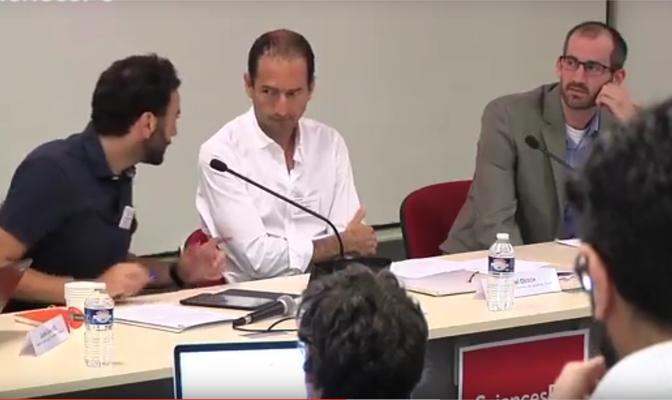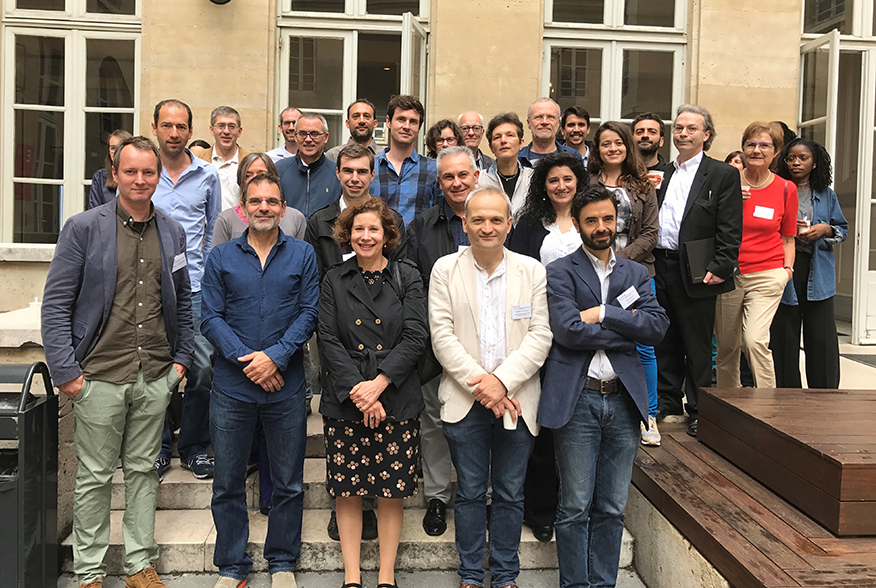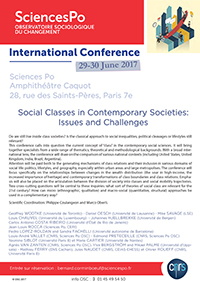Social Classes today...
Social Classes today...

 Social classes conference in Sciences Po (29-30 June 2017)
Social classes conference in Sciences Po (29-30 June 2017)


Social Classes in Contemporary Societies: Issues and Challenges
29-30 June 2017
Sciences Po Paris
Watch the video report made during the event.
The two-day symposium tested the relevance of the approach to better understanding of social and political issues in terms of classes.
All the presentations focused on recent empirical research conducted in various national contexts (Europe, North America, Latin America, South-East Asia) and are based on various methodologies and theoretical approaches.
The symposium highlighted the polysemy of the notion of social class. Three types of definition were mobilized during the presentations.
- A first definition, impregnated with the Marxist filiation and the work of Erik Olin Wright, is based on the criterion of workplace ownership and authority relations.
This definition has been used in several papers on the dynamics of income and wealth inequality (Wodtke, Chauvel) and also partly on political attitudes and voting (Oesch).
- A second definition closely links social classes to occupational groups.
It is the dominant definition in communications devoted to social mobility issues (Costa-Ribeiro, Lopez-Roldan & Fachelli, Vallet), inspired by the work of John Goldthorpe.
- The third definition is part of an inductive, constructivist approach to the notion of class, by closely combining the objective and subjective aspects of the notion.
It readily refers to the sociology of Pierre Bourdieu, insisting on the multi-dimensionality of the concept.
During the colloquium, this third definition was particularly present in communications dealing with questions of class identity (Cartier and Siblot, Rocca), the spatial inscription of class relations (Savage, Préteceille), and cultural capital (Van Zanten, Bergström & Palme), social capital (Hjellbrekke), consumption (Ferry, Naudet and Roueff), but also partly political attitudes (Oesch).
At the end of the symposium, several cross-cutting issues emerged that could inspire future research.
- Question of the impact of school massification on the class structure of the societies in which it takes place, according to different schedule and modalities.
- Question of the wealth, which several speakers have stressed that it is insufficiently and imperfectly addressed in the international literature on inequalities and social classes, often due to lack of appropriate data.
- Question of the relevance of the levels of analysis (local, national, supra-national).
- Finally question at the intersection of both sociology and political science, the mutations of class voting and, more broadly, the expression of class relations in the political field.
Return on the event' goals
If class remains a key dimension for analyzing social structures, social practices and inequalities, we are at the same time aware that it has to be combine with other dimensions such as: education, gender, race and ethnicity, age and generation, and of course place. National and local contexts remain characterized by huge contrasts, with a significant impact on objective and subjective dimensions of everyday life, social experience and social relations, sometimes within the same social group. We decided to organize this conference to confront different approaches, methods and fieldworks in order to better understand how we are dealing with these challenges.
We can make simplistic distinction between two approaches in the way that they refer to social classes. The first one thinks in terms of class social relations (“rapports sociaux”) and considers that they still deeply structure the society and its inequalities. In this mode, the task of the social scientist is precisely to analyze the nature of class relations (domination, alienation, exploitation, etc.) and to identify its new forms. The analysis of inequalities is directly connected to social relations and social conflict (rapports sociaux), which are generated them.
The second one, that we could call “stratificationnist approach” is oriented to the analysis of social inequalities linked to the socio-economic position, without necessarily reflecting on the social relations that link social groups together and that produce these inequalities. The social category is considered as an independent variable that could explain specific inequalities or variation on social representations and practices. The measure of inequalities is central, as well as the measure of social mobility, but giving less importance to social relations and social conflict. The notion itself of social class disappears in favor of notions such as social background, social milieu, and social category. However, in both cases, the analysis of inequalities is crucial, as well the centrality of social belonging in explaining the production and the reproduction of them. Our first naïve question is: Is it possible to better interconnect these two traditions?
If social classes were an hegemonic analytical framework until the early eighties, many factors have contributed to weaken it: the questioning of the centrality of capitalist relations of production and of work in defining the social position of individuals, the decrease and the fragmentation of the working class, and the collapse of the labor movement, the diversification of skills and the appearance of new jobs and new social categories, the impact of various welfare state regimes, the massive access to the job market for women, etc.
Other factors deal with more subjective dimensions such as: the weakening of class identity and class consciousness, the reinforcement of individualism and the crisis of classic forms of collective and political representation, such as political parties, trade-unions, the calling into question of the link between modernity and social progress
It was obvious that we needed to not limited the discussion only to one society. So, we decided to have both people working on other western capitalist societies and people working on so-called emerging countries.









